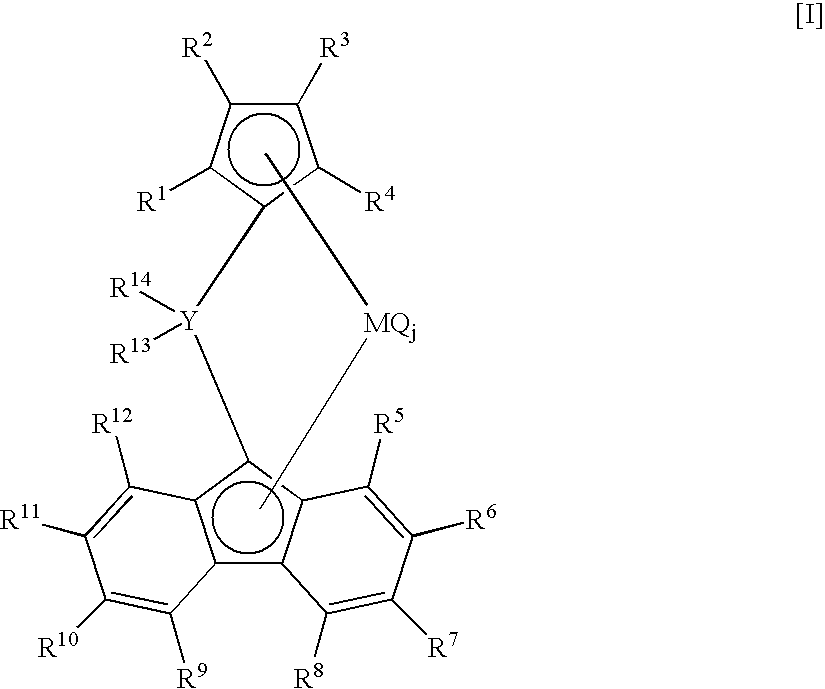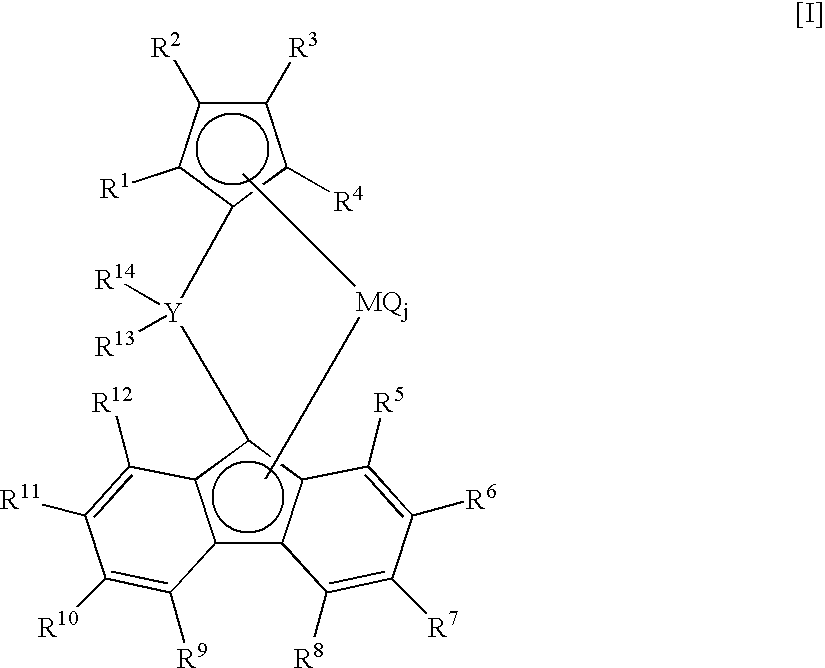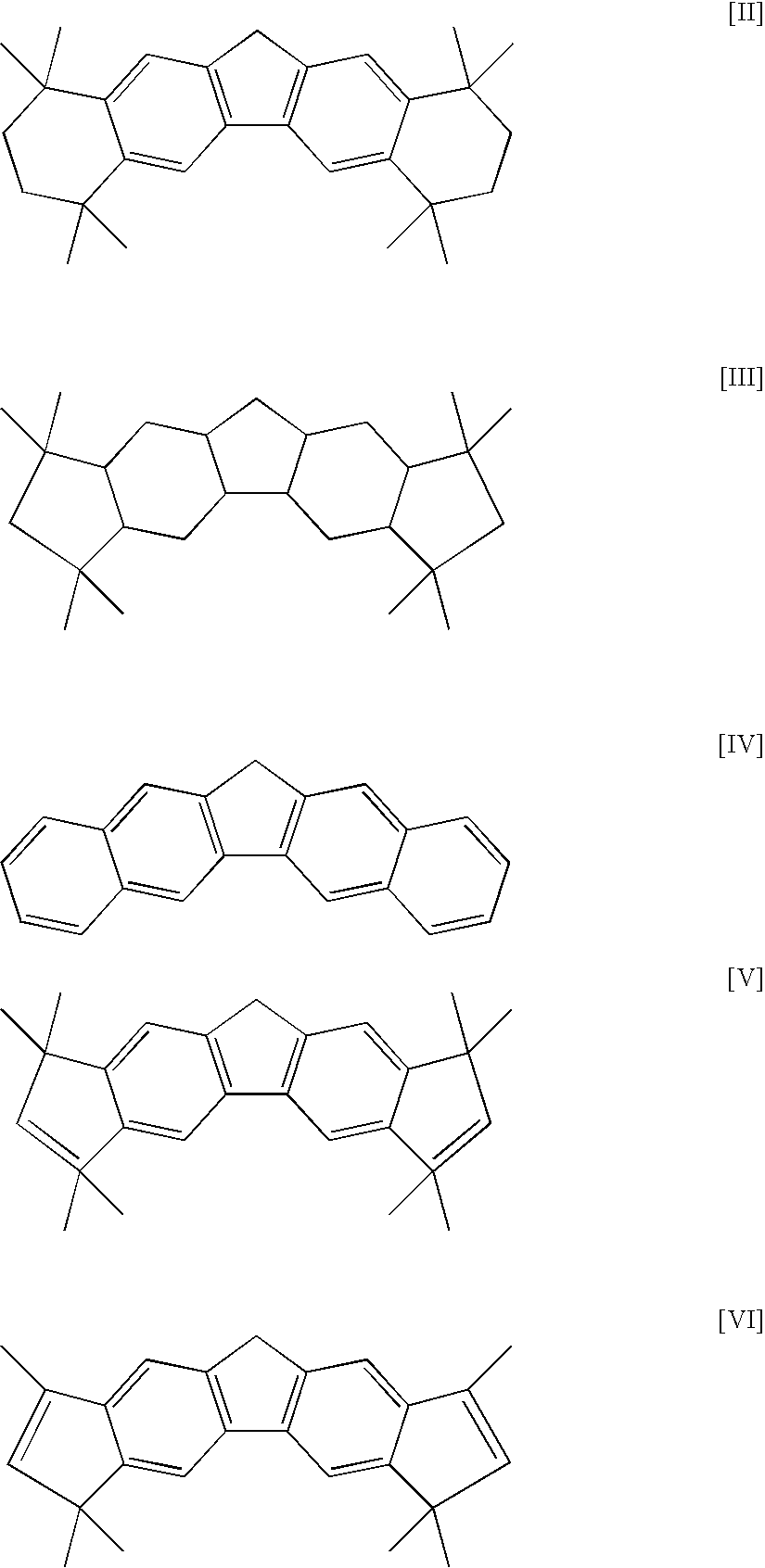Process for producing olefin polymers
a technology of olefin polymer and process, which is applied in the direction of catalyst activation/preparation, physical/chemical process catalyst, chemical/physical process, etc., can solve the problem of difficult to obtain a polymer with a high molecular weight in the low-density region, and achieve high molecular weight, high polymerization activity, and large
- Summary
- Abstract
- Description
- Claims
- Application Information
AI Technical Summary
Benefits of technology
Problems solved by technology
Method used
Image
Examples
example 1
[0084] In a stainless-steel autoclave of 2-liter volume fully flushed with nitrogen, 800 milliliter of hexane and 200 milliliter of 1-octene were charged into the autoclave. After increasing the temperature of the autoclave content to 145° C., the total pressure was set at 3 MPa-G by charging 500 milliliter of hydrogen and feeding ethylene. Next, 0.3 millimole of triisobutylaluminum, 0.001 millimole of di(p-tolyl)methylene(cyclopentadienyl)(octamethyloctahydrodibenzofluorenyl)zirconiumdichloride, and 0.01 millimole of N,N-dimethylaniliniumtetrakis(pentafluophenyl)borate were pressed into the autoclave with nitrogen pressure, and polymerization was started by setting the rotation of a stirrer at 400 rpm. Thereafter, the total pressure was maintained at 3 MPa-G by continuously feeding ethylene only, and polymerization was performed at 150° C. for 30 minutes. After stopping the polymerization by adding a small amount of ethanol to the reaction system, unreacted ethylene was purged. The...
example 2
[Preparation of a Catalyst Solution]
[0086] In a glass flask flushed fully with nitrogen, 0.00025 millimole of di(p-tolyl)methylene(cyclopentadienyl)(octamethyloctahydrodibenzofluorenyl)zirconiumdichloride was charged, and a catalyst solution was prepared by adding a toluene solution containing MAO made by Albemarle Corporation in the amount of 0.0625 millimole equivalent of Al to the flask.
[0087] In a stainless-steel autoclave of 2-liter volume fully flushed with nitrogen, 800 milliliter of hexane and 200 milliliter of 1-octene were charged into the autoclave. After increasing the temperature of the autoclave content to 145° C., the total pressure was set at 3 MPa-G by charging 1,500 milliliter of hydrogen and feeding ethylene. Next, 1.0 millimole of triisobutylaluminum and the catalyst solution prepared as above were pressed into the autoclave by nitrogen pressure, and polymerization was started by setting the rotation of a stirrer at 400 rpm. Thereafter, polymer...
example 3
[Preparation of a Catalyst Solution]
[0089] In a glass flask flushed fully with nitrogen, 0.001 millimole of di(p-tolyl)methylene(cyclopentadienyl)(octamethyloctahydrodibenzofluorenyl)zirconiumdichloride was charged, and a catalyst solution was prepared by adding a toluene solution containing MAO made by Albemarle Corporation in the amount of 0.25 millimole equivalent of Al to the flask.
[0090] In a stainless-steel autoclave of 2-liter volume fully flushed with nitrogen, 800 milliliter of hexane and 200 milliliter of 1-octene were charged into the autoclave. After increasing the temperature of the autoclave content to 175° C., the total pressure was set at 3 MPa-G by charging 1,000 milliliter of hydrogen and feeding ethylene. Next, 1.0 millimole of triisobutylaluminum and the catalyst solution prepared as above were pressed into the autoclave by nitrogen pressure, and polymerization was started by setting the rotation of a stirrer at 400 rpm. Thereafter, polymerizat...
PUM
| Property | Measurement | Unit |
|---|---|---|
| Temperature | aaaaa | aaaaa |
| Temperature | aaaaa | aaaaa |
| Temperature | aaaaa | aaaaa |
Abstract
Description
Claims
Application Information
 Login to View More
Login to View More - R&D
- Intellectual Property
- Life Sciences
- Materials
- Tech Scout
- Unparalleled Data Quality
- Higher Quality Content
- 60% Fewer Hallucinations
Browse by: Latest US Patents, China's latest patents, Technical Efficacy Thesaurus, Application Domain, Technology Topic, Popular Technical Reports.
© 2025 PatSnap. All rights reserved.Legal|Privacy policy|Modern Slavery Act Transparency Statement|Sitemap|About US| Contact US: help@patsnap.com



